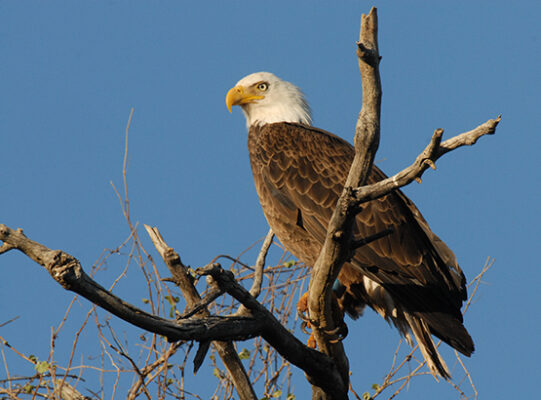Monitoring Breeding Bald Eagles
The Arizona Bald Eagle Nestwatch Program (ABENWP) in Arizona began as a weekend volunteer effort by the U.S. Forest Service and Maricopa Audubon Society in 1978. The program was developed to monitor breeding bald eagles in areas with high recreational pressure. As biologists discovered more nests and identified potential threats to the population, the program expanded into a multiagency effort contracting approximately 20 biologists annually. The nestwatchers collect behavioral data, contact and educate the public within the immediate breeding area, and identify potential threats to the success of the breeding cycle.
Beginning in February, nestwatchers are stationed at 10 to 15 breeding areas with the highest recreational pressures. The on-site protection and education provided by nestwatchers has contributed to a high percentage of the bald eagle’s success. In addition to monitoring the breeding attempt, nestwatchers can also identify individuals in life-threatening situations, making possible a rescue effort by agency biologists. Since 1983, the ABENWP has helped save more than one year in productivity, representing 6.5 percent of all young fledged in Arizona during that time.

Soliciting contracts for the 2025 breeding season
This is your opportunity to be a part of this nationally recognized conservation effort.
Send your current resume to baldeagle@azgfd.gov. Once received, an additional questionnaire will be provided to further assist in our selection process. Initial review of applicants will begin Nov. 18, 2024. Additional applications can be accepted until all openings have been filled by qualified individuals. Contact baldeagle@azgfd.gov with any questions.
*Contact baldeagle@azgfd.gov with questions on how to navigate the application website.
Applications are due by Nov. 18, 2024
Frequently Asked Questions About Nestwatching
Where does monitoring occur?
Monitoring primarily occurs along the Salt and Verde rivers in Arizona National Forests, Native American Lands, and Maricopa County Parks between 1,000 and 4,000 feet in elevation. One breeding area in the White Mountains (9,000 ft) in the central eastern portion of the state will also be monitored.
What are the goals of the Arizona Bald Eagle Nest Watch Program?
There are three goals to the Arizona Bald Eagle Nestwatch Program (ABENWP): data collection, education, and conservation.
- Data collection
Data collection is the most time consuming of the three goals. The focus is on gathering data on breeding behavior (incubation, nest exchanges, nest attendance), foraging attempts, habitat use, prey deliveries, interactions with other wildlife, and human activity in the breeding area.
- Education
Seasonal breeding area closures restricting all foot entry exist around many of the monitored breeding areas. There are a few breeding areas where closures do not exist, but the presence of nestwatchers should be sufficient to protect the area from potentially deleterious human activities. While the closures are posted, the recreating public often find their way into a closed area. Thus, nestwatchers are needed to provide guidance and education to the public on how they can help the bald eagles.
There are always people who say they want to monitor breeding areas where recreational pressures are low. However, the ABENWP exists because of the human activity that may affect the breeding attempt. Without that threat, there would be no program. On the other hand, there are different levels of human activity at the breeding areas we monitor. Those with an educational background may want to choose to monitor a breeding area with higher recreational pressure.
- Conservation
While the word conservation describes why the ABENWP exists, in this context, it means helping save bald eagles in life-threatening situations. When the ABENWP began in 1978, biologists did not realize the impact the ABENWP could have by saving bald eagles. Since 1983, more than one year worth of productivity has been saved from intervening in life-threatening situations. The typical situations encountered are nestlings falling from the nest, entanglement in fishing line, or nests threatened with inundation.
Why become a nestwatcher?
Most often, people who want to be a nestwatcher have recently left college and are looking for experience in the field of wildlife biology. The ABENWP helps you practice some of the more obvious, but important skills of a field biologist.
1) Nestwatchers will camp for extended periods in the field, 10 days at a time for about four months. As a field biologist, being comfortable in this environment is important. Living conditions cannot get in the way of performing the work.
2) Nestwatchers will practice observation skills. None of the bald eagles are telemetered, so all data must be collected through direct observation. Being attentive, as well as anticipating and interpreting the bald eagle behaviors, are important aspects of being a field biologist.
3) Nestwatchers will have the opportunity to collect, interpret, and report on data that has been collected. Bit by bit, it may be a tad boring, but after collecting and organizing all of the data meticulously, a comprehensive report is the final product.
4) Bald eagle management is a multiagency, cooperative effort. While the Arizona Game and Fish Department and the U.S. Fish and Wildlife Service share the lead for bald eagle management activities, many different agencies and Native American Tribes are also involved because of their activities within bald eagle habitat.
5) There are few opportunities where a person can actually watch a family of animals throughout their breeding season and positively affect their outcome. Looking back, people found participating in the ABENWP a valuable experience. It is rare to get the opportunity to watch the chapters unfold in an animal’s life throughout the breeding season and be in a position to positively influence their outcome.
Nestwatchers are the center of Arizona Game and Fish Department’s on-the-ground management efforts at the breeding area. Not only do they collect information to help the managing agencies learn about particular habits of the pairs and how to better manage them, but they also influence people’s opinions about bald eagles. Nestwatchers protect the bald eagles from potentially harmful activities, and if needed, inform the Arizona Game and Fish Department when eagles are in life-threatening situations. Nestwatchers often have the sense of reward and accomplishment at the end of the season.
The ABENWP is a management-based program. All information collected and activities performed are geared toward learning about and protecting the eagles, and increasing their survivability. Most wildlife managers agree that without the ABENWP, there would not be the abundance and distribution of bald eagles that currently exists in Arizona.
What do I do on days off?
The Arizona Game and Fish Department does not provide any housing. The silver lining is that there is an opportunity to explore Arizona. Nestwatchers most often go traveling on their days off. Many have family or friends in the state that they drop in on and bring their nestwatch partners along. The early part of the season is the best time to be in the desert. There are some of the best birding locations in the country in southern Arizona. The scenery throughout the state is spectacular – “Arizona Highways” magazine hasn’t existed for more than 25 years for nothing. As it warms up a bit, it’s time to explore the pine forest, mountain streams, Grand Canyon, etc. Everyone will tell you: Once the season is done, they still haven’t seen everything or been everywhere.
How are breeding areas chosen?
The program will begin with all nestwatchers monitoring about 10 breeding areas. The ins and outs of each breeding area will be discussed. Some people will be limited by the type of vehicle they have because a four-wheel drive is required. After discussing the breeding areas at orientation, nestwatch teams will choose the breeding area that they wish to monitor. If more than one team desires to monitor the same area, then straws will be drawn. There may be a breeding area where two pairs of nestwatchers monitor and have staggered schedules so there is a constant nestwatcher presence. All breeding areas have advantages and disadvantages to them. There isn’t the “perfect” breeding area, but then again, did you expect there to be?
Nestwatchers will stay at the same breeding area throughout the season. However, if a breeding area fails, then, based upon which breeding areas are active, what types of vehicles people have, and what management needs are, teams will be moved to another location. Sometimes people are disappointed in moving because they get comfortable at a breeding area; this is the half-empty attitude. Think of the opportunity to explore other locations in the state, see other pairs of bald eagles, and experience different management challenges. Believe it or not, not all bald eagles behave the same!
How often do nestwatchers get paid, and what is the work schedule?
Nestwatchers get paid after every two 10-day work periods. That means about once a month. Checks will be available during the four-day off period and may be picked up at the Arizona Game and Fish Department office in Phoenix. However, the very first check may take three 10-day periods to arrive. Be prepared.
Nestwatchers perform their contractual duties on a 10-day on, 4-day off schedule. Nestwatchers work with their partners to develop a monitoring schedule within those guidelines, splitting up the day, monitoring together, etc. All days are spent camping in the field.
Want to Get Involved with Wildlife Conservation?
Volunteer your time, or donate to help us with conserving and protecting our wildlife. When you purchase a hunting or fishing license online, resources go back into wildlife conservation.
donate to wildlife conservation
With your help, we can continue to conserve & protect Arizona’s wildlife.
volunteer for projects
If you have a passion for wildlife and want to help us conserve and protect it, we’d love to have you on our team!
